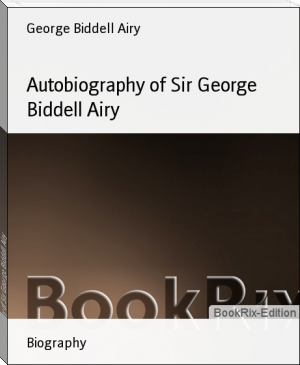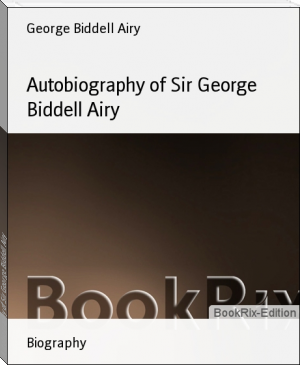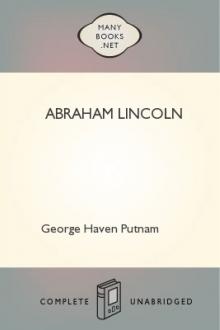Autobiography of Sir George Biddell Airy by George Biddell Airy (e reader for manga .TXT) 📕

- Author: George Biddell Airy
Book online «Autobiography of Sir George Biddell Airy by George Biddell Airy (e reader for manga .TXT) 📕». Author George Biddell Airy
worn away from some of the threads. The old screws were consequently discarded, and new ones were made by Mr Simms.--The adjustment of the Spectroscope has occupied a great deal of attention. There was astigmatism of the prisms; and false light reflected from the base of the prisms, causing loss both of light and of definition. The latter defect was corrected by altering the angles, and then astigmatism was corrected by a cylindrical lens near the slit. The definition in both planes was then found to be perfect.--The number of small planets has now become so great, and the interest of establishing the elements of all their orbits so small,--while at the same time the light of all those lately discovered is very faint, and the difficulty and doubt of observation greatly increased,--that I have begun to think seriously of limiting future observations to a small number of these objects.--All observations with the Spectroscope have been completely reduced; the measures of lines in the spectra of elements being converted into corresponding wave-lengths, and the observations of displacement of lines in the spectra of stars being reduced so as to exhibit the concluded motion in miles per second, after applying a correction for the earth's motion. Sixteen measures of the F line in the spectrum of the Moon as compared with hydrogen give a displacement corresponding to a motion of less than two miles a second, which seems to shew that the method of comparison now adopted is free from systematic error; and this is supported by the manner in which motions of approach and recession are distributed among the stars examined on each night of observation. The results recently obtained appear to be on the whole as consistent as can be expected in such delicate observations, and they support in a remarkable manner the conclusions of Dr Huggins, with regard to the motions of those stars which he examined.--Photographs of the sun have been taken with the photoheliograph on 182 days. On one of the photographs, which was accidentally exposed while the drop slit was being drawn up, there appears to be a faint image of a cloud-like prominence close to the sun's limb, though the exposure probably only amounted to a fraction of a second. A prominence of unusual brilliancy was seen with the Spectroscope about the same time and in the same position with reference to the Sun's limb. All groups of Sun-spots and faculae have been numbered, and the dates of their first and last appearances entered up to the present time. Areas of spots have been measured, and the measures have been reduced to millionths of the Sun's visible hemisphere.--The examination of the readings of the deep-sunk thermometers from 1846 to 1873 has exhibited some laws which had been sufficiently established before this time, and some which were less known. Among the former were the successive retardations of seasons in successive descents, amounting to about four months at the depth of 25 feet; and the successive diminutions of the annual range of temperature. Among the latter is the character of the changes from year to year, which the great length of this series of observations brings well to light. It is found that from year to year the mean temperature of the surface for the year, varying by three or four degrees of Fahrenheit, follows in its changes the mean temperature of the atmosphere for the year, and that the changes of annual temperature are propagated downwards, retarded in phase and diminishing in amount of change, in the same manner (though probably not following the same law) as the season changes. The inference from this is, that changes of temperature come entirely from the exterior and in no discoverable degree from the interior; an inference which may be important in regard both to solar action and to geology. --Referring to the Transit of Venus observations: In the astronomical part of the reductions, there has been great labour and difficulty in the determination of local sidereal times; some books of observations required extensive transcription; some instrumental errors are still uncertain; the latter determinations have perplexed us so much that we are inclined to believe that, in spite of the great facilities of reduction given by the transit instrument, it would be better to rely on the altazimuth for time-determinations.... In the photographic part, I have confined my attention entirely to measures of the distance between the centres of the Sun and Planet, a troublesome and complex operation.--Referring to the progress of the Numerical Lunar Theory: With a repetition of grant from the Treasury, I have usually maintained four junior computers on this work. The progress, though considerable, has not been so great as I had hoped, by reason of the excessive personal pressure upon me during the whole year.--I wrote a letter of congratulation to Le Verrier on the completion of his great work of Planetary Tables.--On May 13th the Queen was at South Kensington, and I attended to explain the astronomical instruments, and shewed Her Majesty one of the Transit of Venus photographs."
Of private history: He returned from his Playford visit on the 18th of January.--In April there was a two-day trip to Colchester.--From June 13th to July 12th he was travelling in the North of Scotland and the Orkneys with his daughters, staying for a short time with Mr Webster, M.P., at Aberdeen, and with Mr Newall at Newcastle.--In September there was a week's run to Birkenhead and Keswick.--In November a week's run to Playford.--From the 13th to 15th of December he was at Cambridge, and on the 28th he went to Playford for the usual winter stay there.
1877
"In April of this year I was much engaged on the subject of Mr Gill's expedition to Ascension to observe for the determination of the parallax of Mars at the approaching opposition of that planet.--A large Direct-vision Spectroscope has been quite recently made by Mr Hilger under Mr Christie's direction on a new plan, in which either great dispersion or great purity of spectrum is obtained by the use of 'Half-prisms,' according as the incident pencil falls first on the perpendicular or on the oblique face. In this Spectroscope either one or two half prisms can be used at pleasure, according to the dispersion required, and there is facility for increasing the train to three or four half-prisms, though the dispersion with two only is nearly double of that given by the large ten-prism Spectroscope. The definition in this form of Spectroscope appears to be very fine.--At the end of May 1876, spectroscopic determinations of the Sun's rotation were made by observations of the relative displacement of the Fraunhofer lines at the east and west limbs respectively. The results are in close agreement with the value of the rotation found from observations of Sun-spots. A similar determination has also been made in the case of Jupiter, with equally satisfactory results.--An Electrometer on Sir William Thomson's plan, for continuous photographic registration of atmospheric electricity has been received from Mr White of Glasgow. It was mounted in December.--The computation of the photographic records of the barometer from 1854 to 1873 has so far advanced that we can assert positively that there is no trace of lunar tide in the atmosphere; but that there is a strongly marked semi-diurnal solar tide, accompanied with a smaller diurnal tide. We are at present engaged in comparing the barometric measures with the directions of the wind.--Regarding the distribution of the printed observations: There is no extensive wish for separate magnetic observations, but general magnetic results are in great demand, especially for mining operations, and to meet this a map of magnetic declination is furnished in the newspaper called the 'Colliery Guardian.'--As regards the operations for the Transit of Venus: The computing staff has by degrees been reduced to two junior computers within the Observatory; and one or two computers external to the Observatory, who are employed on large groups of systematic calculations. The principal part of the calculations remaining at the date of the last Report was that applying to the determination of the geographical longitudes of fundamental stations. At the moment of my writing, the last of these (the longitude of Observatory Bay, Kerguelen) is not absolutely finished:... The method of determining the geographical longitude of the principal station in each group by vertical transits of the Moon has been found very successful at Honolulu and Rodriguez. For stations in high south latitude, horizontal transits are preferable.--As regards the Numerical Lunar Theory: With the view of preserving, against the ordinary chances of destruction or abandonment, a work which is already one of considerable magnitude, I have prepared and have printed as Appendix to the Greenwich Observations (with additional copies as for a separate work) the ordinary Equations of Lunar Disturbance, the novel theory of Symbolical Variations, and the Numerical Developments of the quantities on the first side of the Equations.--At various times from February to May I was engaged on the reduction of Malta Tides, and on a Paper concerning the same.--In July I was awarded the Albert Medal for my Compass corrections, and received the same from the Prince of Wales.--In February, Campbell's instrument for the registration of sunshine was introduced: it was mounted in July."
Of private history: "I was at Playford until Jan. 19th, in close correspondence as usual with Mr Christie at the Observatory, and attending to my Numerical Lunar Theory.--From Mar. 29th to Apr. 2nd I went on a short trip to Hereford, Worcester, &c.--From June 8th to 20th I was at Playford.--From Aug. 13th to Sept. 8th Airy was on an expedition in Ireland, chiefly in the North and West, with his daughters. When at Dublin he visited Grubb's instrument factory. On the return journey he stayed for some time in the Lake District of Cumberland, and took soundings in the neighbourhood of the place of the 'floating island' in Derwentwater."
Airy took the greatest interest in antiquarian matters, whether military or ecclesiastical, and his feelings on such matters is well illustrated by the following letter:
ROYAL OBSERVATORY, GREENWICH, S.E.
1877, February 27 .
DEAR SIR,
I venture to ask if you can assist me in the following matter.
In the Parish Church of Playford, near Ipswich, Suffolk, was a splendid brass tombstone to Sir Thomas Felbrigg. By an act of folly and barbarism, almost unequalled in the history of the world, the Incumbent and Curate nearly destroyed the brass inscription surrounding the image of the Knight.
This tombstone is figured in Gough's Sepulchral Antiquities, which, I presume, is to be found in the British Museum.
And I take the liberty to ask if you would kindly look at the engraving, and give me any suggestion as to the way in which some copies of it could be made, in a fairly durable form. I am connected with the parish of Playford, and am anxious to preserve for it this memorial of a family of high rank formerly resident there.
I am, dear Sir,
Very faithfully yours,
Of private history: He returned from his Playford visit on the 18th of January.--In April there was a two-day trip to Colchester.--From June 13th to July 12th he was travelling in the North of Scotland and the Orkneys with his daughters, staying for a short time with Mr Webster, M.P., at Aberdeen, and with Mr Newall at Newcastle.--In September there was a week's run to Birkenhead and Keswick.--In November a week's run to Playford.--From the 13th to 15th of December he was at Cambridge, and on the 28th he went to Playford for the usual winter stay there.
1877
"In April of this year I was much engaged on the subject of Mr Gill's expedition to Ascension to observe for the determination of the parallax of Mars at the approaching opposition of that planet.--A large Direct-vision Spectroscope has been quite recently made by Mr Hilger under Mr Christie's direction on a new plan, in which either great dispersion or great purity of spectrum is obtained by the use of 'Half-prisms,' according as the incident pencil falls first on the perpendicular or on the oblique face. In this Spectroscope either one or two half prisms can be used at pleasure, according to the dispersion required, and there is facility for increasing the train to three or four half-prisms, though the dispersion with two only is nearly double of that given by the large ten-prism Spectroscope. The definition in this form of Spectroscope appears to be very fine.--At the end of May 1876, spectroscopic determinations of the Sun's rotation were made by observations of the relative displacement of the Fraunhofer lines at the east and west limbs respectively. The results are in close agreement with the value of the rotation found from observations of Sun-spots. A similar determination has also been made in the case of Jupiter, with equally satisfactory results.--An Electrometer on Sir William Thomson's plan, for continuous photographic registration of atmospheric electricity has been received from Mr White of Glasgow. It was mounted in December.--The computation of the photographic records of the barometer from 1854 to 1873 has so far advanced that we can assert positively that there is no trace of lunar tide in the atmosphere; but that there is a strongly marked semi-diurnal solar tide, accompanied with a smaller diurnal tide. We are at present engaged in comparing the barometric measures with the directions of the wind.--Regarding the distribution of the printed observations: There is no extensive wish for separate magnetic observations, but general magnetic results are in great demand, especially for mining operations, and to meet this a map of magnetic declination is furnished in the newspaper called the 'Colliery Guardian.'--As regards the operations for the Transit of Venus: The computing staff has by degrees been reduced to two junior computers within the Observatory; and one or two computers external to the Observatory, who are employed on large groups of systematic calculations. The principal part of the calculations remaining at the date of the last Report was that applying to the determination of the geographical longitudes of fundamental stations. At the moment of my writing, the last of these (the longitude of Observatory Bay, Kerguelen) is not absolutely finished:... The method of determining the geographical longitude of the principal station in each group by vertical transits of the Moon has been found very successful at Honolulu and Rodriguez. For stations in high south latitude, horizontal transits are preferable.--As regards the Numerical Lunar Theory: With the view of preserving, against the ordinary chances of destruction or abandonment, a work which is already one of considerable magnitude, I have prepared and have printed as Appendix to the Greenwich Observations (with additional copies as for a separate work) the ordinary Equations of Lunar Disturbance, the novel theory of Symbolical Variations, and the Numerical Developments of the quantities on the first side of the Equations.--At various times from February to May I was engaged on the reduction of Malta Tides, and on a Paper concerning the same.--In July I was awarded the Albert Medal for my Compass corrections, and received the same from the Prince of Wales.--In February, Campbell's instrument for the registration of sunshine was introduced: it was mounted in July."
Of private history: "I was at Playford until Jan. 19th, in close correspondence as usual with Mr Christie at the Observatory, and attending to my Numerical Lunar Theory.--From Mar. 29th to Apr. 2nd I went on a short trip to Hereford, Worcester, &c.--From June 8th to 20th I was at Playford.--From Aug. 13th to Sept. 8th Airy was on an expedition in Ireland, chiefly in the North and West, with his daughters. When at Dublin he visited Grubb's instrument factory. On the return journey he stayed for some time in the Lake District of Cumberland, and took soundings in the neighbourhood of the place of the 'floating island' in Derwentwater."
Airy took the greatest interest in antiquarian matters, whether military or ecclesiastical, and his feelings on such matters is well illustrated by the following letter:
ROYAL OBSERVATORY, GREENWICH, S.E.
1877, February 27 .
DEAR SIR,
I venture to ask if you can assist me in the following matter.
In the Parish Church of Playford, near Ipswich, Suffolk, was a splendid brass tombstone to Sir Thomas Felbrigg. By an act of folly and barbarism, almost unequalled in the history of the world, the Incumbent and Curate nearly destroyed the brass inscription surrounding the image of the Knight.
This tombstone is figured in Gough's Sepulchral Antiquities, which, I presume, is to be found in the British Museum.
And I take the liberty to ask if you would kindly look at the engraving, and give me any suggestion as to the way in which some copies of it could be made, in a fairly durable form. I am connected with the parish of Playford, and am anxious to preserve for it this memorial of a family of high rank formerly resident there.
I am, dear Sir,
Very faithfully yours,
Free e-book «Autobiography of Sir George Biddell Airy by George Biddell Airy (e reader for manga .TXT) 📕» - read online now
Similar e-books:





Comments (0)